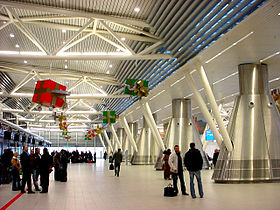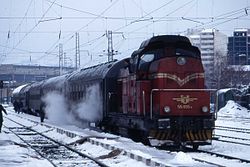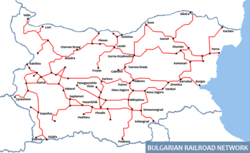- Transport in Bulgaria
-
Transport in Bulgaira is facilitated with road, air, rail, and water networks.
Contents
Air transport
After the second terminal of International Airport Sofia was built the total number of passengers rose and reached 3 230 696 in 2008, and in April 2011 Airport Sofia serviced 282 694 passengers, 13% more than the same period of 2009, when the record was 250 000 passengers.[1] In 2011 passenger traffic at Bulgaria's three major airports - Sofia, Varna and Bourgas - grew up to near 10% on the year to 3.89 million in the first half of 2011, due to rise of customers using international routes and launch of new destinations.[2]
In the past aviation compared with road and railroad transport used to be a minor mode of freight movement, and only 860,000 passengers used Bulgarian airlines in 2001.[3] In 2008 Bulgaria had 204 airports, 127 of which had paved runways.[4] One airport, Sofia Airport, had a runway longer than 3,000 meters, and there were four heliports.[3] The second- and third-largest airports, Varna Airport and Burgas Airport, serve mainly charter flights and have regular domestic links with the capital.[3] In the early 2000s, Sofia Airport received substantial renovation, with aid from a Kuwaiti-led consortium, in anticipation of increased air connections with Europe.[3] A three-phase expansion was scheduled for completion in 2010.[3] The communist-era state airline, Balkan Airlines, was replaced by Bulgaria Air, for which a private owner was to be selected from among bidders by the end of 2006.[3][dated info] In 2005 Bulgaria Air transported 517,000 passengers to international destinations, including all major European cities[3]
Railways
In 2005 Bulgaria had some 6,238 kilometers of open access track owned by the state company "National Company Railway Infrastructure", including a 125 kilometers long 760 mm narrow gauge railway - the Septemvri-Dobrinishte narrow gauge line.[5] Sofia, Plovdiv and Gorna Oriahovitsa are the hubs of the domestic system and of international rail connections.[5]
Bulgaria's rail system has not expanded since the 1980s, but there are upgrading projects underway.[5] Current top operating speed is 130 km/h, with the national top speed record is 197 km/h set between Iskar and Elin Pelin with a leased Siemens Taurus electric locomotive. The top operating speed is soon to be increased to 160 km/h after the completion of the Krumovo - Dimitrovgrad - Svilengrad electrification and upgrading. There are also plans for upgrading for high speed operation and doubling (where needed) of the Plovdiv - Burgas railway.
In the mid-2000s, railways remained a major mode of freight transportation, but with increasing problems with the maintenance of the infrastructure and lowering speeds, highways carried a progressively larger share of freight.[5] The national passenger and freight operator is called Bulgarian State Railways, but there are also a number of private operators including Bulgarian Railway Company and DB Schenker Rail Bulgaria.
Sofia Metro
In 1998 the first six kilometers of an often-interrupted 52-kilometer standard gauge subway project (Sofia Metro) opened in Sofia.[5] Additional stations were opened recently and with the last one that opened on the 7th of September 2009, the subway reached total length of 18 kilometers with 14 stations. Construction of the second line started in December 2008, which is due to be opened according to initial forecasts by the end of 2012.[dated info][5]
Rail links to adjacent countries
- Same gauge (standard gauge)
 Greece — via Kulata - Promachonas and Svilengrad - Orestiada
Greece — via Kulata - Promachonas and Svilengrad - Orestiada Macedonia — indirectly via Niš in Serbia or via Thessaloniki in Greece
Macedonia — indirectly via Niš in Serbia or via Thessaloniki in Greece Romania — via Ruse, Bulgaria (Danube Bridge - over the river Danube) with Giurgiu, Romania and through Kardam - Negru Voda. A new bridge with a high speed link between Vidin and Calafat is under construction.
Romania — via Ruse, Bulgaria (Danube Bridge - over the river Danube) with Giurgiu, Romania and through Kardam - Negru Voda. A new bridge with a high speed link between Vidin and Calafat is under construction. Serbia — via Kalotina - Dimitrovgrad, Serbia. Currently being electrified.[6]
Serbia — via Kalotina - Dimitrovgrad, Serbia. Currently being electrified.[6] Turkey — via Svilengrad - Kapikule. Currently being electrified.[6]
Turkey — via Svilengrad - Kapikule. Currently being electrified.[6]
Roads
Building new highways is one of the top goals of the 2009 elected government of Boyko Borisov, therefore new roads and highways are regularly opened for use.
In the early 2000s, Bulgaria had some 37,300 kilometers of roads, all but 3,000 of which were paved but nearly half of which (18,000 kilometers) fell into the lowest international rating for paved roads. 324 kilometers of high-speed highways were in service in 2005. As of 2011, 480 kilometers are in service. Roads have overtaken the railroads as the chief mode of freight transportation.
Long-term plans call for upgrading higher-quality roads and integrating the road system into the European grid. The focus is on improving road connectors with Turkey and Greece and domestic connections linking Sofia, Plovdiv, and Burgas. Bulgaria has delayed building some key highway connections since the 1990s, but European Union membership is a strong incentive for completion. The National Strategy for Integrated Infrastructure Development calls for construction of 720 kilometers of new highways by 2015. A 114-kilometer link between eastern Bulgaria and the Turkish border is scheduled for completion in 2010. As of 2004, two international highways passed through Bulgaria, and a major highway ran from Sofia to the Black Sea coast. Proposed international corridors would pass from north to south, from Vidin to the border with Greece and from Ruse to the border with Greece, and west to east, from Serbia through Sofia to Burgas, Varna, and Edirne (Turkey). A new bridge link with Romania is scheduled for completion in 2011, relieving road and railroad congestion in that direction.[5]
Motorways
 Trakiya motorway - Sofia - Plovdiv - Stara Zagora - Karnobat - Burgas (Stara Zagora to Karnobat under construction)
Trakiya motorway - Sofia - Plovdiv - Stara Zagora - Karnobat - Burgas (Stara Zagora to Karnobat under construction) Hemus motorway - Sofia - Yablanitsa - Shumen - Varna (Yablanitsa to Shumen left)
Hemus motorway - Sofia - Yablanitsa - Shumen - Varna (Yablanitsa to Shumen left) Cherno More motorway - Varna to Burgas (planned)
Cherno More motorway - Varna to Burgas (planned) Maritsa motorway - Parvomay to Kapitan Andreevo (under construction)
Maritsa motorway - Parvomay to Kapitan Andreevo (under construction) Lyulin motorway - Sofia to Pernik
Lyulin motorway - Sofia to Pernik Struma motorway - (Sofia) Pernik to Kulata (under construction - Dolna Dikanya to Sandanski left)
Struma motorway - (Sofia) Pernik to Kulata (under construction - Dolna Dikanya to Sandanski left)
- total: 44,033 km
- paved: 43,593 km (99%)
- unpaved: 440 km (1%)
- motorways: 463 km (2011)
- motorways under construction: 218 km (2011)
Timetables
Civil transportation is well developed in Bulgaria. There are several big companies, which control the market and hundreds of small (one bus = one company), which operate between the smaller towns. The main problem with so many companies is how to find their timetables. Recently the project "bgrazpisanie" (BG timetable in English) succeeded to collect all Bulgarian civil transportation timetables on its website www.BGrazpisanie.com [1]
Waterways
Pipelines
In 2005 Bulgaria had 2,425 kilometers of natural gas pipelines, 339 kilometers of oil pipelines, and 156 kilometers of pipelines for refined products.[5] The pipeline system was scheduled for substantial changes and additions, however.[5] The 279-kilometer Burgas-Alexandroupolis Pipeline, still under negotiation among Bulgaria, Greece, and Russia in 2006, would provide a bypass of the overloaded Bosporus Strait.[5] The line would enable Russian oil arriving at the Bulgarian oil port of Burgas to reach Greece’s Mediterranean port at Alexandroupolis.[5] A 900-kilometer U.S.- financed alternate route, known as the AMBO pipeline, would bring oil from Burgas across Bulgaria and Macedonia to the Albanian port of Vlore on the Adriatic Sea, bypassing both the Bosporus and Greece.[5] As of October 2006, approval of both pipelines was expected.[5][dated info] With international investment, Bulgaria began constructing a new domestic gas transportation network beginning in 2005.[5] The Russian Gazprom company planned a gas pipeline from Dimitrovgrad in eastern Bulgaria across Serbia, reaching the Adriatic Sea in Croatia.[5] Some 400 kilometers of the planned Nabucco Pipeline, bringing gas from Azerbaijan and Iran to Central Europe, were to cross Bulgaria sometime before 2011.[5]
Ports and harbours
River ports
Lom, Rousse, Vidin, Silistra, Tutrakan, Svishtov, Nikopol and Oryahovo are river ports on the Danube river.
Sea ports
Burgas, Nesebar, Varna, Tsarevo, Sozopol, Pomorie, Obzor, Kavarna, Balchik.
The major and largest ports with international significance are Varna and Burgas.
Merchant marine
- total: 75 ships (with a volume of 1,000 gross register tons (GRT) or over) 872,653 GRT/1,294,877 metric tons deadweight (DWT)
- ships by type:
- bulk carrier 40
- cargo ship 17
- chemical tanker 4
- container ship 6
- passenger ship/cargo ship 1
- petroleum tanker 3
- Roll-on/roll-off ship 4
See also
References
- ^ Sofia Airport Serviced Record Number of Passengers April 2011, Sofia News Agency, May 16, 2011
- ^ Passenger traffic at Bulgaria's major airports grows 10% Y/Y in H1 2011, The Sofia Echo, August 18, 2011
- ^ a b c d e f g Bulgaria country profile, p. 15.
- ^ CIA World Factbook Bulgaria
- ^ a b c d e f g h i j k l m n o p Bulgaria country profile, p. 14.
- ^ a b "Bulgaria to Turkey wiring underway". Railway Gazette. 2010. http://www.railwaygazette.com/news/single-view/view/10/bulgaria-to-turkey-wiring-underway.html. Retrieved 2010-07-05.
 This article incorporates public domain material Bulgaria country profile (October 2006) from websites or documents of the Library of Congress Federal Research Division.
This article incorporates public domain material Bulgaria country profile (October 2006) from websites or documents of the Library of Congress Federal Research Division.External links
- Prime Minister Borisov vows to build seven new highways
- Truck transport Bulgaria
- Executive Agency Marinetime Administration
- Executive agency for Exploration and Maintenance of the Danube river
Transport in Europe Sovereign
states- Albania
- Andorra
- Armenia
- Austria
- Azerbaijan
- Belarus
- Belgium
- Bosnia and Herzegovina
- Bulgaria
- Croatia
- Cyprus
- Czech Republic
- Denmark
- Estonia
- Finland
- France
- Georgia
- Germany
- Greece
- Hungary
- Iceland
- Ireland
- Italy
- Kazakhstan
- Latvia
- Liechtenstein
- Lithuania
- Luxembourg
- Macedonia
- Malta
- Moldova
- Monaco
- Montenegro
- Netherlands
- Norway
- Poland
- Portugal
- Romania
- Russia
- San Marino
- Serbia
- Slovakia
- Slovenia
- Spain
- Sweden
- Switzerland
- Turkey
- Ukraine
- United Kingdom
- (England
- Northern Ireland
- Scotland
- Wales)
- Vatican City
States with limited
recognition- Abkhazia
- Kosovo
- Nagorno-Karabakh
- Northern Cyprus
- South Ossetia
- Transnistria
Dependencies
and other territories- Åland
- Faroe Islands
- Gibraltar
- Guernsey
- Jan Mayen
- Jersey
- Isle of Man
- Svalbard
Other entities - European Union
Categories: - Same gauge (standard gauge)
Wikimedia Foundation. 2010.






